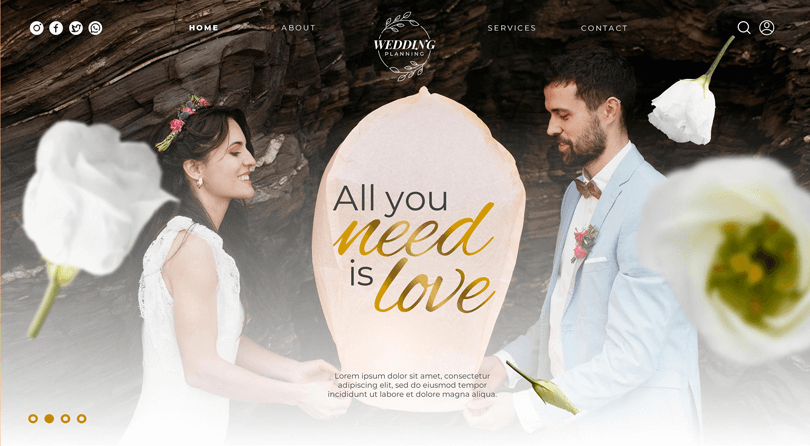Creating a wedding website is a wonderful way to share your love story, event details, and essential information with your guests. In just 8 simple steps, you can build a personalized online hub that reflects your unique style and celebrates the journey to your special day.
From selecting the ideal platform, such as WordPress, every decision plays a crucial role in enhancing your website’s appeal. Adding engaging content and incorporating useful design elements, like a countdown timer, significantly boosts your site’s functionality and charm.
Let’s have a look at the guide on how to create a wedding website where your love shines, and your guests feel warmly welcomed.
What is a wedding website?
A wedding website serves as a central online hub for couples to share crucial details, including event schedules, RSVP options, and personal stories. It organizes vital information into user-friendly sections for guests, making navigation simple. From finding the venue to suggesting places to stay, it covers everything.

With the inclusion of wedding photographs and love stories, it becomes a digital diary documenting the couple’s journey. Regular updates keep everyone informed about any changes or new things like dress code tips easily.
Ultimately, it creates a seamless and enjoyable experience for both the couple and their guests, fostering anticipation and connection before the big day.
Importance of having a wedding website
Having a wedding website can be highly beneficial for couples planning their big day. Here are several reasons why having a wedding website is important:
Centralized Information Hub: A wedding website serves as a central location for all the important information regarding the wedding. This includes details about the venue, date, time, dress code, directions, accommodation options, and registry information.
Convenience for Guests: Guests can access the wedding website at their convenience to find all the necessary information they need for the event. This saves their time and effort, especially if they need to refer back to certain details multiple times.
RSVP Management: Many wedding websites offer RSVP functionality, allowing guests to RSVP directly on the website. This makes it easier for couples to manage guest lists, meal preferences, and other logistical details. It also eliminates the need for paper RSVP cards, reducing waste and simplifying the wedding planning process.
Customization: Couples can personalize their wedding website to reflect their unique style and preferences. They can choose themes, colors, and layouts that complement their wedding theme, creating a cohesive look and feel for their event.
Communication Tool: Wedding websites provide a platform for couples to communicate important updates and announcements to their guests. Whether it’s changes to the schedule, additional information about the venue, or reminders about deadlines, couples can easily communicate with their guests through the website.
Gift Registry: Couples can include links to their gift registries on their wedding website. This makes it easy for guests to locate and buy gifts.
This approach guarantees that guests can easily access the couple’s preferred registries. It also removes the need for couples to distribute multiple links or give out registry information separately.
Recommended Blogs for You:
👉 5 Best Elementor Image Zoom Widgets
👉 6 Top Elementor Blockquote Widgets You Should Be Using Right Now
👉 Top Elementor Event Box Widget for Your Online Store
👉 6 Best Elementor Chart Widgets: Boost Your Website’s Appeal
👉 Top Elementor Calendar Widget for your Website
How to Create a Wedding Website: 8 Easy Steps
Creating a wedding website can be a fun and practical way to share important information with your guests and keep them updated on the details of your big day. Here’s a step-by-step guide on how to create a wedding website:
Step 1: Choosing the Right Platform (WordPress Recommended)
Choosing the best website builder for your wedding website is essential since it will affect how simple it is to set up and maintain. WordPress is frequently suggested because it provides a selection of wedding-specific, fully configurable themes and plugins. Its intuitive UI allows individuals to use it easily regardless of their web design experience.
Step 2: Setting Up Your Domain and Hosting
A domain name is the web address where people will find your wedding website (e.g., www.johnandsarahwedding.com). Choose a domain name that is easy to remember and reflects the couple or the wedding theme.
Once you have your domain, you’ll need hosting, where your website’s files will be stored and made accessible on the Internet. Various hosting providers are available, so choose one that suits your budget and offers reliable service.
Step 3: Install & Configuration WordPress on your server
After setting up your domain and hosting, you have to install WordPress on your server. Many hosting providers offer a simple, one-click installation process for WordPress. Once installed, you’ll need to configure basic settings such as the site title, admin email, password, tagline, and other preferences. This step may also involve selecting a theme for your website, although you can customize this later.
Step 4: Enhancing Your Website Design with HT Mega Plugin
Enhancing your wedding website design involves a thoughtful approach to ensuring it is both visually appealing and user-friendly for your guests. Here is a solution for you. Elevate your WordPress website with HT Mega, the ultimate addon package for Elementor.

HT Mega addon for Elementor page builder offers a comprehensive range of design tools and elements to elevate your website’s appearance. This complete package includes 170+ pre-designed website templates, as well as 10+ elementor widgets such as accordions, banners, photo galleries, forms, tables, and more.
Additionally, it provides multiple layout options for showcasing your photos and stories, including three portfolio styles and over four blog designs. Its user-friendly design and array of beneficial features enhance your wedding website’s appeal.
Whether you need a pre-made template, elementor widget, Gutenberg Block, or any other design element, this plugin provides everything you need to customize your website to reflect your unique style and preferences.
Step 5: Adding Essential Content and Pages
Now it’s time to create the main pages of your wedding website to provide important information to your guests:
Home Page: The home page is the first thing visitors will see when they arrive at your site. Include a warm welcome message, photos of the couple, and details about the wedding dates and location.
Our Story: This page is an opportunity to share the love story of the couple. Include engaging text, photos, and a timeline of significant events in your relationship.
Event Details: It provides detailed information about the wedding events, including the ceremony venue, reception venue, maps, and schedules for each part of the day.
RSVP: Set up a user-friendly RSVP form using a tool like Elementor, which allows guests to easily confirm their attendance. You can also include fields for dietary preferences, song requests, and other pertinent information in the rsvp form.
Gallery: Create a photo gallery showcasing special moments leading up to the wedding, such as engagement photos, bridal showers, and other pre-wedding celebrations.
Accommodations and Travel: Help out-of-town guests by listing recommended lodging options, travel tips, nearby attractions, and any special discounts or deals available.
Step 6: User Experience and Mobile Optimization
Ensure that your wedding website is easy to navigate and visually appealing on all devices, including smartphones, tablets, and desktop computers. This means choosing a responsive design that adjusts seamlessly to different screen sizes and optimizing images and content for fast loading times.
Step 7: Integrate a Countdown Timer
Integrate a Countdown Timer to create anticipation for the wedding day on your website. The HT Mega’s Elementor Countdown Widget provides a straightforward and impactful method to showcase a timer ticking down to the big event. It offers 7 styles for a customizable experience. You can adjust colors, fonts, and layout to create a timer that aligns with your brand identity, making it easy to track time until the celebration begins.
Utilize the HT Mega Elementor Countdown Widget to swiftly craft an attractive and functional countdown timer. This widget, available within the HT Mega free package, doesn’t necessitate any coding or design expertise. Simply place the countdown widget into the content area of your website to effortlessly add this exciting feature.
Step 8: Testing, Launching, and Sharing Your Wedding Website
Before making your website live, thoroughly test all its features and pages to ensure everything works correctly. Check for typos, broken links, and any formatting issues. Once you’re satisfied, it’s time to launch your website and share it with your guests. Consider sending out the link via email, social media, or traditional invitations to ensure everyone knows where to find all the important wedding details.
Must-Have Elements for The Wedding Website
Here are the must-have elements for the wedding website:
Your Story: Tell the story of your love, from when you first met to the magical moment of your proposal, sharing the joy with your visitors through your beautiful wedding website.
RSVP Functionality: An online RSVP feature simplifies the process for both the guests and the couple. Ensure it’s easy to find and use. It should also be able to manage different responses for multiple events.
Wedding Date: Make sure everyone knows the date of your big day so guests can mark their calendars and be there to celebrate with you.
Wedding Gifts: Help guests with gift ideas by sharing your registry or preferences, making it simple for them to choose something special for you.
Wedding Location: Give clear details about where your wedding will be, including the address, maps, and nearby places to stay, so guests can find their way easily.
Photographs: Share memorable photos of your journey together, letting guests see the love story that’s brought you to this amazing moment.
Engagement Photo: Show off a beautiful engagement photo that gets everyone excited for your upcoming wedding, adding an extra touch of anticipation to the celebration.
Frequently Asked Questions
How do I make my wedding website secure?
To ensure the security of your wedding website, use a reputable hosting provider with SSL encryption, strong passwords, and regular updates to protect against cyber threats.
How much does a wedding website cost?
The cost of a wedding website can vary widely, from free options available through various DIY platforms to premium custom designs that may cost up to $20,000. The price largely depends on the level of customization and the features you choose to include on your site.
Can I make a free wedding website?
Yes, you can create a free wedding website using various online platforms that offer templates specifically designed for weddings. These platforms often provide easy-to-use tools for customization, allowing you to personalize your site.
How long does it take to set up a wedding website?
Setting up a wedding website generally takes a few hours to a day, depending on the platform and customization. Gather essential details beforehand to streamline the process.
Should I include a registry on my wedding website?
Including a registry on your wedding website is a great idea. It makes choosing gifts easier by linking directly to stores or items. This helps guests pick the right gift and ensures you get what you need.
How can I ensure my wedding website is easy to navigate?
To make your wedding website easy to navigate, prioritize a clear and simple layout. Organize the content with intuitive menus and clearly labeled sections to quickly access important information like venue details, event schedules, and accommodation options.
Conclusion
Creating a wedding website is an invaluable asset for today’s couples. It becomes a central hub where guests can easily access all vital information. If you’re wondering how to create a wedding website, begin by sharing your unique love story, detailing event specifics, and offering seamless RSVP options.
These elements not only enhance communication but also heighten anticipation for your special day. Utilizing straightforward platforms like WordPress and adaptable plugins like HT Mega simplifies the process of designing a bespoke website, making it both fun and straightforward. Ready to create a memorable wedding website? Start building your unique online presence today.
